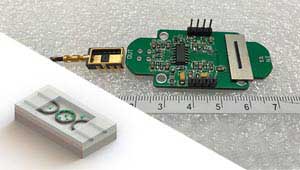| Posted: Apr 05, 2016 |
Lighting the way to new sensors
(Nanowerk News) Many machines such as turbines, oil-drills, health monitors and nuclear reactors require internal sensors to monitor physical states such as temperature. To meet this challenge, researchers at A*STAR are developing compact silicon photonic sensors that can provide accurate readings without being damaged by the toxic, corrosive or even explosive conditions within the machines ("Demonstration of a photonic-based linear temperature sensor." and "A novel photonic dew-point hygrometer with ultra-high accuracy").
|
|
The expanding field of silicon photonics uses structures called waveguides to confine electromagnetic waves to one or two dimensions, so that the wave will change in response to external factors. Waveguides can be extremely small and are easily integrated into electronic circuits to record information.
|
|
In a recent example of their work, Ji Fang Tao from A*STAR’s Institute of Microelectronics and co-workers developed a tiny optical temperature sensor just 120 by 80 micrometers and modeled on a classic experimental design called the Michelson Interferometer1. The device splits light into two beams, which travel through different materials and are then brought back together. The resulting interference pattern gives information about the light and the surrounding temperature.
|
 |
| A schematic (left) and photograph (right) of a photonic dew point temperature sensor developed by Ji Fang Tao and co-workers, which works by detecting changes in the refraction of light as water molecules condense onto the device. ((left) © 2015 IEEE. Reprinted, with permission, from Ref 1. (right) © 2016 A*STAR Institute of Microelectronics)
|
|
“Changes in temperature can change the optical properties of some materials,” explains Tao. “In our sensor, the temperature changes the refractive index of the waveguides. The Michelson Interferometer is a powerful design that allows us to pick up these refractive changes, and therefore work out the temperature changes.”
|
|
One of the standout features of the device is that it does not require mirrors, and instead guides light through loops to bring it back to the interference point. The researchers found that it could measure a wide range of temperatures, and was also around 20 times more sensitive to small temperature changes than existing fiber-optic sensors.
|
|
Temperature is just one property that Tao and his team can measure using silicon photonics. Recently, they developed a tiny photonic hygrometer (see image) which identifies the local dew-point temperature by recognizing the refractive properties of water when droplets condense in the path of the waves2. This information can then be combined with the temperature sensor to calculate relative humidity with a very high level of accuracy.
|
|
The applications of such versatile, compact and low-cost environmental sensors could be unlimited, and Tao and co-workers from Singapore and China are only at the beginning of their journey. “Silicon photonics and optical microelectromechanical systems (MEMS) are two amazing technologies for sensor development,” he says. “Now we can measure temperature, dew-point and humidity with ultrahigh accuracy, the next step is to design on-chip photonic gas sensors.”
|

